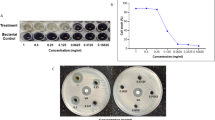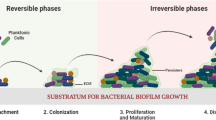Abstract
Staphylococcus aureus is a most important reason of bacterial keratitis. The emergence of S. aureus resistance to methicillin necessitates searching for new antimicrobial components for keratitis. CM11 is a cationic peptide with strong antibacterial activity against a range of bacteria. In this study, in vitro bactericidal activity of CM11 was investigated using the time-killing assay. For this purpose, corneal methicillin-resistant S. aureus (MRSA)-infected rabbit models were experimentally developed through intrastromal injection of bacteria. The infected rabbits were treated in three groups by artificial tear, gentamicin, and CM11, and their conjunctiva, iris, and cornea were clinically examined using a slit lamp and histopathological examination. The variance analyses of microbial (colony counts) and pathological examinations on the harvested cornea samples showed a significant improvement in the treated groups (CM11 and gentamicin) compared to the control eyes (P ≤ 0.05). According to findings, CM11 and gentamicin could significantly reduce the CFU in comparison with the group received artificial tear. The mean bacterial counts (log CFU/ml) from corneal culture were 2.1, 5.02, and 8.89 for gentamicin, CM11, and control group, respectively (P ≤ 0.05). The above-mentioned findings displayed the efficacy of CM11 cationic peptide for curing the MRSA-mediated keratitis.





Similar content being viewed by others
References
Albus U (2012) Guide for the care and use of laboratory animals, 8th edn. SAGE Publications, London
Amani J, Barjini AK, Moghaddam M, Asadi A (2015) In vitro synergistic effect of the CM11 antimicrobial peptide in combination with common antibiotics against clinical isolates of six species of multidrug-resistant pathogenic bacteria. Protein Pept Lett 22:940–951
Azad ZM, Moravej H, Fasihi-Ramandi M, Masjedian F, Nazari R, Mirnejad R, Moghaddam MM (2017) In vitro synergistic effects of a short cationic peptide and clinically used antibiotics against drug-resistant isolates of Brucella melitensis. J Med Microbiol 66:919–926
Beisel K, Hazlett L, Berk R (1983) Dominant susceptibility effect on the murine corneal response to Pseudomonas aeruginosa. Proc Soc Exp Biol Med 172:488–491
Boman H, Wade D, Boman I, Wåhlin B, Merrifield R (1989) Antibacterial and antimalarial properties of peptides that are cecropin-melittin hybrids. FEBS Lett 259:103–106
Brown L (2007) Resistance to ocular antibiotics: an overview. Clin Exp Optom 90:258–262
Cao Y, Yu RQ, Liu Y, Zhou HX, Song LL, Cao Y (2010) Design, recombinant expression, and antibacterial activity of the cecropins–melittin hybrid antimicrobial peptides. Curr Microbiol 61:169–175
Chang VS, Dhaliwal DK, Raju L, Kowalski RP (2015) Antibiotic resistance in the treatment of Staphylococcus aureus keratitis: a 20-year review. Cornea 34:698
Chen CH, Lu TK (2020) Development and challenges of antimicrobial peptides for therapeutic applications. Antibiotics 9:24
Clemens LE et al (2017) Designed host defense peptides for the treatment of bacterial keratitis. Invest Ophthalmol Vis Sci 58:6273–6281
De La Fuente-Núñez C, Cardoso MH, de Souza Cândido E, Franco OL, Hancock RE (2016) Synthetic antibiofilm peptides. Biochim Biophys Acta (BBA) Biomembr 1858:1061–1069
Deguchi H et al (2018) The trend of resistance to antibiotics for ocular infection of Staphylococcus aureus, coagulase-negative staphylococci, and Corynebacterium compared with 10-years previous: a retrospective observational study. PLoS ONE 13:e0203705
Durrani AF, Atta S, Bhat A, Mammen A, Dhaliwal D, Kowalski RP, Jhanji V (2020) Methicillin-resistant Staphylococcal aureus keratitis: initial treatment, risk factors, clinical features, and treatment outcomes. Am J Ophthalmol. https://doi.org/10.1016/j.ajo.2020.03.017
Egrilmez S, Yildirim-Theveny Ş (2020) Treatment-resistant bacterial keratitis: challenges and solutions. Clin Ophthalmol 14:287
Epand RM, Epand RF (2009) Lipid domains in bacterial membranes and the action of antimicrobial agents. Biochim Biophys Acta Biomembr 1788:289–294
Griffith GL, Kasus-Jacobi A, Pereira HA (2017) Bioactive antimicrobial peptides as therapeutics for corneal wounds and infections. Adv Wound Care 6:175–190
Hollmann A, Martinez M, Maturana P, Semorile LC, Maffia PC (2018) Antimicrobial peptides: interaction with model and biological membranes and synergism with chemical antibiotics. Front Chem 6:204
Holve DL, Gum GG, Pritt SL (2013) Effect of sedation with xylazine and ketamine on intraocular pressure in New Zealand white rabbits. J Am Assoc Lab Anim Sci 52:488–490
Kolar SSN, Luca V, Baidouri H, Mannino G, McDermott AM, Mangoni ML (2015) Esculentin-1a (1-21) NH2: a frog skin-derived peptide for microbial keratitis. Cell Mol Life Sci 72:617–627
Lakhundi S, Zhang K (2018) Methicillin-resistant Staphylococcus aureus: molecular characterization, evolution, and epidemiology. Clin Microbiol Rev 31:e00020
Lalitha P et al (2017) Trends in antibiotic resistance in bacterial keratitis isolates from South India. Br J Ophthalmol 101:108–113
Lei J et al (2019) The antimicrobial peptides and their potential clinical applications. Am J Transl Res 11:3919
Mannis MJ (2002) The use of antimicrobial peptides in ophthalmology: an experimental study in corneal preservation and the management of bacterial keratitis. Trans Am Ophthalmol Soc 100:243
Miller D (2017) Update on the epidemiology and antibiotic resistance of ocular infections Middle East. Afr J Ophthalmol 24:30
Moghaddam MM, Abolhassani F, Babavalian H, Mirnejad R, Barjini KA, Amani J (2012) Comparison of in vitro antibacterial activities of two cationic peptides CM15 and CM11 against five pathogenic bacteria: Pseudomonas aeruginosa, Staphylococcus aureus, Vibrio cholerae, Acinetobacter baumannii, and Escherichia coli. Probiot Antimicrob Proteins 4:133–139
Moghaddam MM, Aghamollaei H, Kooshki H, Barjini KA, Mirnejad R, Choopani A (2015) The development of antimicrobial peptides as an approach to prevention of antibiotic resistance. Rev Med Microbiol 26:98–110
Moravej H, Moravej Z, Yazdanparast M, Heiat M, Mirhosseini A, Moosazadeh Moghaddam M, Mirnejad R (2018) Antimicrobial peptides: features, action, and their resistance mechanisms in bacteria. Microbial Drug Resistance 24:747–767
Pfalzgraff A, Brandenburg K, Weindl G (2018) Antimicrobial peptides and their therapeutic potential for bacterial skin infections and wounds. Front Pharmacol 9:281
Ramandi F, Piranfar V, Nadoushan M, Sarshoori J, Misialek M, Heiat M, Moosazadeh Moghaddam M (2017) Dose-response effects of the CM11 as a short cationic antimicrobial peptide on histopathological and biochemical changes in mice. Curr Chem Biol 11:150–157
Robles-Contreras A, Perez-Cano HJ, Babayan-Sosa A, Baca-Lozada O (2013) Bacterial keratitis infection: a battle between virulence factors and the immune response. Common Eye Infect 85:842–847
Sharma A (2018) The pharmacist’s role in managing microbial keratitis. US Pharm 43:27–30
Suzuki T (2011) A new target for Staphylococcus aureus associated with keratitis. Cornea 30:S34–S40
Teweldemedhin M, Gebreyesus H, Atsbaha AH, Asgedom SW, Saravanan M (2017) Bacterial profile of ocular infections: a systematic review. BMC Ophthalmol 17:212
Wang N, Yang Q, Tan Y, Lin L, Huang Q, Wu K (2015) Bacterial spectrum and antibiotic resistance patterns of ocular infection: differences between external and intraocular diseases. J Ophthalmol 2015:813979
Wayne P (2009) Method for dilution antimicrobial susceptibility tests for bacteria that grow aerobically approved standard CLSI document M07-A8, 8th edn. Clinical and Laboratory Standards Institute (CLSI), Wayne
Wilhelmus KR (2001) The Draize eye test. Surv Ophthalmol 45:493–515
Yeu E, Hauswirth S (2020) A review of the differential diagnosis of acute infectious conjunctivitis: implications for treatment and management. Clin Ophthalmol 14:805
Funding
No financial support was received for this submission.
Author information
Authors and Affiliations
Corresponding author
Ethics declarations
Conflict of interest
None of the authors has conflict of interest with this submission.
Additional information
Publisher's Note
Springer Nature remains neutral with regard to jurisdictional claims in published maps and institutional affiliations.
Rights and permissions
About this article
Cite this article
Aghamollaei, H., Safabakhsh, H., Moosazadeh Moghaddam, M. et al. Evaluation of a Cationic Antimicrobial Peptide as the New Antibiotic Candidate to Treat Staphylococcus aureus Keratitis. Int J Pept Res Ther 27, 755–762 (2021). https://doi.org/10.1007/s10989-020-10126-3
Accepted:
Published:
Issue Date:
DOI: https://doi.org/10.1007/s10989-020-10126-3




